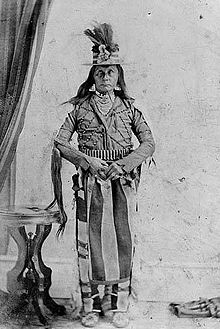
The Yakama are a Native American tribe with nearly 10,851 members, based primarily in eastern Washington state.

Walla Walla, Walawalałáma, sometimes Walúulapam, are a Sahaptin indigenous people of the Northwest Plateau. The duplication in their name expresses the diminutive form. The name Walla Walla is translated several ways but most often as "many waters".

The Cayuse are a Native American tribe in what is now the state of Oregon in the United States. The Cayuse tribe shares a reservation and government in northeastern Oregon with the Umatilla and the Walla Walla tribes as part of the Confederated Tribes of the Umatilla Indian Reservation. The reservation is located near Pendleton, Oregon, at the base of the Blue Mountains.
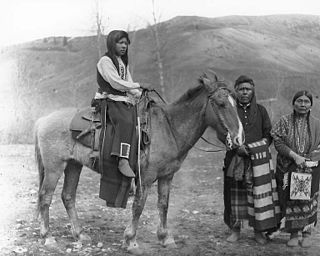
The Palouse are a Sahaptin tribe recognized in the Treaty of 1855 with the United States along with the Yakama. It was negotiated at the 1855 Walla Walla Council. A variant spelling is Palus. Today they are enrolled in the federally recognized Confederated Tribes and Bands of the Yakama Nation and some are also represented by the Colville Confederated Tribes, the Confederated Tribes of the Umatilla Indian Reservation and Nez Perce Tribe.
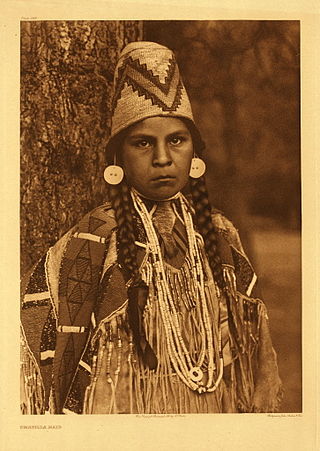
The Umatilla are a Sahaptin-speaking Native American tribe who traditionally inhabited the Columbia Plateau region of the northwestern United States, along the Umatilla and Columbia rivers.

The Whitman massacre refers to the killing of American missionaries Marcus and Narcissa Whitman, along with eleven others, on November 29, 1847. They were killed by a small group of Cayuse men who accused Whitman of poisoning 200 Cayuse in his medical care during an outbreak of measles that included the Whitman household. The killings occurred at the Whitman Mission at the junction of the Walla Walla River and Mill Creek in what is now southeastern Washington near Walla Walla. The massacre became a decisive episode in the U.S. settlement of the Pacific Northwest, causing the United States Congress to take action declaring the territorial status of the Oregon Country. The Oregon Territory was established on August 14, 1848, to protect the white settlers.
The Cayuse War was an armed conflict that took place in the Northwestern United States from 1847 to 1855 between the Cayuse people of the region and the United States Government and local American settlers. Caused in part by the influx of disease and settlers to the region, the immediate start of the conflict occurred in 1847 when the Whitman massacre took place at the Whitman Mission near present-day Walla Walla, Washington when thirteen people were killed in and around the mission. Over the next few years the Provisional Government of Oregon and later the United States Army battled the Native Americans east of the Cascades. This was the first of several wars between the Native Americans and American settlers in that region that would lead to the negotiations between the United States and Native Americans of the Columbia Plateau, creating a number of Indian reservations.

Tiloukaikt was a Native American leader of the Cayuse tribe in the northwestern United States. He was involved in the Whitman Massacre and was a primary leader during the subsequent Cayuse War.

The history of Washington includes thousands of years of Native American history before Europeans arrived and began to establish territorial claims. The region was part of Oregon Territory from 1848 to 1853, after which it was separated from Oregon and established as Washington Territory following the efforts at the Monticello Convention. On November 11, 1889, Washington became the 42nd state of the United States.

The Yakima War (1855–1858), also referred to as the Plateau War or Yakima Indian War, was a conflict between the United States and the Yakama, a Sahaptian-speaking people of the Northwest Plateau, then part of Washington Territory, and the tribal allies of each. It primarily took place in the southern interior of present-day Washington. Isolated battles in western Washington and the northern Inland Empire are sometimes separately referred to as the Puget Sound War and the Coeur d'Alene War, respectively.

The Battle of Four Lakes was a battle during the Coeur d'Alene War of 1858 in the Washington Territory in the United States. The Coeur d'Alene War was part of the Yakima War, which began in 1855. The battle was fought near present-day Four Lakes, Washington, between elements of the United States Army and a coalition of Native American tribes consisting of Schitsu'umsh, Palus, Spokan, and Yakama warriors.

Piupiumaksmaks was head chief of the Walla Walla tribe and son to the preceding chief Tumatapum. His name meant Yellow Bird, but it was often mistranslated as Yellow Serpent by Europeans.
Sahaptin or Shahaptin, endonym Ichishkin, is one of the two-language Sahaptian branch of the Plateau Penutian family spoken in a section of the northwestern plateau along the Columbia River and its tributaries in southern Washington, northern Oregon, and southwestern Idaho, in the United States; the other language is Nez Perce or Niimi'ipuutímt.
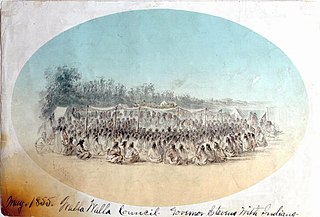
The Walla Walla Council (1855) was a meeting in the Pacific Northwest between the United States and sovereign tribal nations of the Cayuse, Nez Perce, Umatilla, Walla Walla, and Yakama. The council occurred on May 29 – June 11; the treaties signed at this council on June 9 were ratified by the U.S. Senate four years later in 1859.

Qualchan was a 19th-century Yakama chieftain who participated in the Yakama War with his Uncle Kamiakin and other chieftains.

The Battle of Toppenish Creek was the first engagement of the Yakima War in Washington. Fought on October 5, 1855, a company of American soldiers, under Major Granville O. Haller, was attacked by a band of Yakamas, under Chief Kamiakin, and compelled to retreat. The battle occurred in Yakima Valley, 113 miles northwest of Fort Walla Walla, along Toppenish Creek and was a major victory for Native American forces.
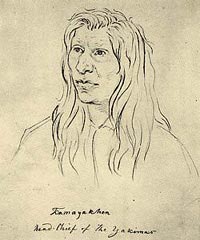
The Battle of Union Gap, or the Battle at Union Gap, was the second engagement of the Yakama War, fought on November 9 and 10, 1855. It began when a large force of about 700 American soldiers, under Major Gabriel J. Rains, discovered Chief Kamiakin's village of around 300 braves and several women and children, along the Yakima River. In the following two-day battle only one "non-combatant" was killed by accident and the Yakama men were forced to retreat with their women and children.
Tawatoy or Young Chief, variously spelled as Tauitowe, Tauatui, Tauitau, Tawatoe or Tu Ah Tway, was a Cayuse headman. Alongside his brother Five Crows, Tawatoy held sway over one of three bands of the Cayuse nation.
The history of Walla Walla, Washington begins with the settling of Oregon Country, Fort Nez Percés, the Whitman Mission and Walla Walla County, Washington.

The Battle of Walla Walla was the longest battle fought during the Yakima War. The battle began on December 7, 1855, and ended on December 11, 1855. The battle was fought between six companies of the Oregon Mounted Volunteers and the Walla Walla. Fighting alongside the Walla Walla were members of several different tribes, such as the Cayuse, Palouse and Yakama.
